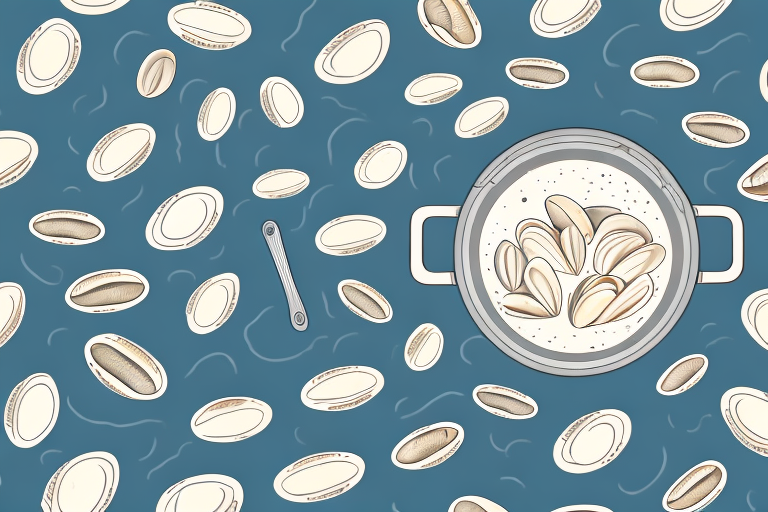Clams have long been a favorite seafood dish of many, enjoyed either cooked and steamed or freshly shucked as an appetizer. But if you’re looking for a way to enjoy this seafood delicacy without having to keep it alive until cooking, frozen clams are a great choice! Cooking frozen clams may seem daunting at first, but with a few simple steps, you can have a delicious meal ready in no time. In this guide, we’ll cover the process of cooking frozen clams, health benefits of consuming them, and tips to ensure perfectly cooked results every time.
Preparing the Frozen Clams
The first step in cooking frozen clams is to properly prepare them. Start by removing the clams from their packaging and placing them in a strainer or colander. Carefully rinse the clams in cold running water for several minutes. Use your hands to gently rub the shells to loosen any accumulated dirt and debris. When finished, give the clams one final rinse and place them on a cutting board.
Once the clams are on the cutting board, you can begin to remove any beards or barnacles that may be present. To do this, use a sharp knife to carefully cut away the beard or barnacle. Be sure to take your time and be careful not to cut into the clam itself. Once the beards and barnacles have been removed, the clams are ready to be cooked.
Cooking the Frozen Clams
Next, you’ll need to decide how you want to cook the clams. The most popular method is to steam them—this is an easy and effective way to prepare frozen clams. Start by filling a large pot with an inch and a half of water, then bring the water to a boil. Place the clams in the pot and cover them with a tight-fitting lid. Reduce the heat to medium-low and allow the clams to cook undisturbed for 8 to 10 minutes. Once cooked, the shells should be open, indicating the clams are ready to be served.
Selecting the Right Clam Variety
It’s important to select the right variety of chilled or frozen clams for your recipe. There are several varieties available, including littlenecks, cherrystones, quahogs, and Mahogany clams. Generally, littlenecks are best for enjoying raw or lightly cooked as an appetizer, cherrystones can be steamed or simmered for chowders and salads, quahogs are better for chowders or stuffings, and the mahogany variety is a large hard-shell clam often used in chowders or steaming recipes.
Prepping the Frozen Clams for Cooking
If your recipe calls for shucked clams, you’ll need to first prep them before cooking. This involves carefully removing each clam from its shell by prying it open with your finger or a flat edge knife. Carefully remove any remaining bits of shell and discard any clams that don’t open after cooking. Once shucked, rinse the clams in cold water to remove any debris before cooking.
Health Benefits of Eating Frozen Clams
Besides tasting great, frozen clams are also incredibly nutritious. They are a great source of vitamins and minerals such as zinc, iron, selenium, and calcium; they are also rich in high-quality protein, essential fatty acids, and dietary fiber. Eating frozen clams regularly can help promote heart health and reduce inflammation—plus, they are a low-calorie way to add seafood to almost any type of dish.
Tips for Cooking Frozen Clams Perfectly
When cooking frozen clams, timing is key! Other tips for ensuring perfectly cooked results include using a tightly-fitting lid to trap steam and prevent overcooking during steaming; adding herbs and spices during cooking to infuse flavor; and using a thermometer to monitor internal temperature when baking or roasting. Remember that the clams should be cooked until the shells open—if they don’t open after cooking, discard them.
Troubleshooting Common Problems with Cooking Frozen Clams
It can be difficult to troubleshoot problems with cooking frozen clams. Common issues include overcooking, not enough steam trap, and not enough seasoning. If your clams are overcooked, they will be dry or rubbery in texture. To prevent this, use a thermometer when baking or roasting and a tightly-fitting lid when steaming. If there is not enough steam trap, add an additional two tablespoons of water to the pot before cooking to ensure proper steaming. Lastly, if your clams appear flavorless after cooking, consider seasoning them with herbs and spices or adding a touch of lemon juice to brighten up their flavor.
Serving Ideas for Cooked Frozen Clams
Once cooked properly, frozen clams taste delicious in a variety of dishes ranging from salads and soups to sandwiches and pasta. For an easy dinner idea, try tossing cooked frozen clams in a skillet with garlic butter, lemon juice, parsley, and white wine for a classic Mediterranean-style dish. Alternatively, use pre-cooked clams as the main ingredient in clam chowder or stuff them in mini pies for an impressive appetizer.










